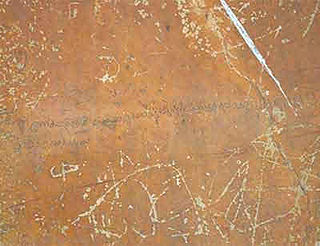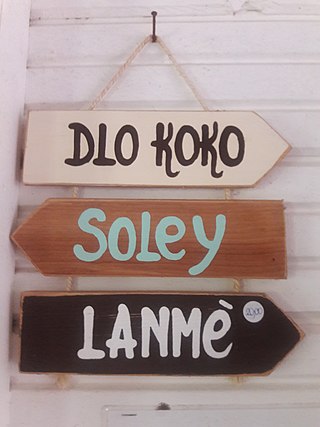In articulatory phonetics, a consonant is a speech sound that is articulated with complete or partial closure of the vocal tract, except for the h, which is pronounced without any stricture in the vocal tract. Examples are and [b], pronounced with the lips; and [d], pronounced with the front of the tongue; and [g], pronounced with the back of the tongue;, pronounced throughout the vocal tract;, [v], and, pronounced by forcing air through a narrow channel (fricatives); and and, which have air flowing through the nose (nasals). Most consonants are pulmonic, using air pressure from the lungs to generate a sound. Very few natural languages are non-pulmonic, making use of ejectives, implosives, and clicks. Contrasting with consonants are vowels.
Pig Latin is a language game, argot, or cant in which words in English are altered, usually by adding a fabricated suffix or by moving the onset or initial consonant or consonant cluster of a word to the end of the word and adding a vocalic syllable to create such a suffix. For example, Wikipedia would become Ikipediaway. The objective is often to conceal the words from others not familiar with the rules. The reference to Latin is a deliberate misnomer; Pig Latin is simply a form of argot or jargon unrelated to Latin, and the name is used for its English connotations as a strange and foreign-sounding language. It is most often used by young children as a fun way to confuse people unfamiliar with Pig Latin.
Tone is the use of pitch in language to distinguish lexical or grammatical meaning—that is, to distinguish or to inflect words. All oral languages use pitch to express emotional and other para-linguistic information and to convey emphasis, contrast and other such features in what is called intonation, but not all languages use tones to distinguish words or their inflections, analogously to consonants and vowels. Languages that have this feature are called tonal languages; the distinctive tone patterns of such a language are sometimes called tonemes, by analogy with phoneme. Tonal languages are common in East and Southeast Asia, Africa, the Americas and the Pacific.

The glottal stop or glottal plosive is a type of consonantal sound used in many spoken languages, produced by obstructing airflow in the vocal tract or, more precisely, the glottis. The symbol in the International Phonetic Alphabet that represents this sound is ⟨ʔ⟩.
A mora is a basic timing unit in the phonology of some spoken languages, equal to or shorter than a syllable. For example, a short syllable such as ba consists of one mora (monomoraic), while a long syllable such as baa consists of two (bimoraic); extra-long syllables with three moras (trimoraic) are relatively rare. Such metrics are also referred to as syllable weight.

Yoruba is a language that is spoken in West Africa, primarily in Southwestern and Central Nigeria. It is spoken by the ethnic Yoruba people. The number of Yoruba speakers is roughly 47 million, including about 2 million second-language speakers. As a pluricentric language, it is primarily spoken in a dialectal area spanning Nigeria, Benin, and Togo with smaller migrated communities in Côte d'Ivoire, Sierra Leone and The Gambia.

Sinhala, sometimes called Sinhalese, is an Indo-Aryan language primarily spoken by the Sinhalese people of Sri Lanka, who make up the largest ethnic group on the island, numbering about 16 million. Sinhala is also spoken as the first language by other ethnic groups in Sri Lanka, totalling about 2 million speakers as of 2001. It is written using the Sinhala script, which is a Brahmic script closely related to the Grantha script of South India.

Hadza is a language isolate spoken along the shores of Lake Eyasi in Tanzania by around 1,000 Hadza people, who include in their number the last full-time hunter-gatherers in Africa. It is one of only three languages in East Africa with click consonants. Despite the small number of speakers, language use is vigorous, with most children learning it, but UNESCO categorizes the language as vulnerable.

The Yupik languages are a family of languages spoken by the Yupik peoples of western and south-central Alaska and Chukotka. The Yupik languages differ enough from one another that they are not mutually intelligible, although speakers of one of the languages may understand the general idea of a conversation of speakers of another of the languages. One of them, Sirenik, has been extinct since 1997.

Antillean Creole is a French-based creole that is primarily spoken in the Lesser Antilles. Its grammar and vocabulary include elements of French, Carib, English, and African languages.
The English language as primarily spoken by Hispanic Americans on the East Coast of the United States demonstrates considerable influence from New York City English and African-American Vernacular English, with certain additional features borrowed from the Spanish language. Though not currently confirmed to be a single stabilized dialect, this variety has received some attention in the academic literature, being recently labelled New York Latino English, referring to its city of twentieth-century origin, or, more inclusively, East Coast Latino English. In the 1970s scholarship, the variety was more narrowly called (New York) Puerto Rican English or Nuyorican English. The variety originated with Puerto Ricans moving to New York City after World War I, though particularly in the subsequent generations born in the New York dialect region who were native speakers of both English and often Spanish. Today, it covers the English of many Hispanic and Latino Americans of diverse national heritages, not simply Puerto Ricans, in the New York metropolitan area and beyond along the northeastern coast of the United States.
Phuthi (Síphùthì) is a Nguni Bantu language spoken in southern Lesotho and areas in South Africa adjacent to the same border. The closest substantial living relative of Phuthi is Swati, spoken in Eswatini and the Mpumalanga province of South Africa. Although there is no contemporary sociocultural or political contact, Phuthi is linguistically part of a historic dialect continuum with Swati. Phuthi is heavily influenced by the surrounding Sesotho and Xhosa languages, but retains a distinct core of lexicon and grammar not found in either Xhosa or Sesotho, and found only partly in Swati to the north.

Miskito is a Misumalpan language spoken by the Miskito people in northeastern Nicaragua, especially in the North Caribbean Coast Autonomous Region, and in eastern Honduras.
The phonology of the Persian language varies between regional dialects, standard varieties, and even from older variates of Persian. Persian is a pluricentric language and countries that have Persian as an official language have separate standard varieties, namely: Standard Dari (Afghanistan), Standard Iranian Persian (Iran) and Standard Tajik (Tajikistan). The most significant differences between standard varieties of Persian are their vowel systems. Standard varieties of Persian have anywhere from 6 to 8 vowel distinctions, and similar vowels may be pronounced differently between standards. However, there are not many notable differences when comparing consonants, as all standard varieties a similar amount of consonant sounds. Though, colloquial varieties generally have more differences than their standard counterparts. Most dialects feature contrastive stress and syllable-final consonant clusters. Linguists tend to focus on Iranian Persian, so this article may contain less adequate information regarding other varieties.
This article deals with the phonology of the standard Ukrainian language.
Libyan Arabic, also called Sulaimitian Arabic by scholars, is a variety of Arabic spoken in Libya, and neighboring countries. It can be divided into two major dialect areas; the eastern centred in Benghazi and Bayda, and the western centred in Tripoli and Misrata. The Eastern variety extends beyond the borders to the east and share the same dialect with far Western Egypt, Western Egyptian Bedawi Arabic, with between 90,000 and 474,000 speakers in Egypt. A distinctive southern variety, centered on Sabha, also exists and is more akin to the western variety. Another Southern dialect is also shared along the borders with Niger with 12,900 speakers in Niger as of 2021.

Mandombe or Mandombé is a script proposed in 1978 in Mbanza-Ngungu in the Bas-Congo province of the Democratic Republic of the Congo by Wabeladio Payi, who related that it was revealed to him in a dream by Simon Kimbangu, the prophet of the Kimbanguist Church. Mandombe is based on the sacred shapes and , and intended for writing African languages such as Kikongo, as well as the four national languages of the Congo, Kikongo ya leta, Lingala, Tshiluba and Swahili, though it does not have enough vowels to write Lingala fully. It is taught in Kimbanguist church schools in Angola, the Republic of the Congo, and the Democratic Republic of the Congo. It is also promoted by the Kimbanguist Centre de l’Écriture Négro-Africaine (CENA). The Mandombe Academy at CENA is currently working on transcribing other African languages in the script. It has been classified as the third most viable indigenous script of recent indigenous west African scripts, behind only the Vai syllabary and the N'Ko alphabet.
The orthography of the Sotho language is fairly recent and is based on the Latin script, but, like most languages written using the Latin alphabet, it does not use all the letters; as well, several digraphs and trigraphs are used to represent single sounds.
The Woleai or Caroline Island script, thought to have been a syllabary, was a partially Latin-based script indigenous to Woleai Atoll and nearby islands of Micronesia and used to write the Woleaian language until the mid-20th century. At the time the script was first noticed by Europeans, this part of Micronesia was known as the Caroline Islands, hence the name Caroline Island script.

Kelabit is one of the most remote languages of Borneo, on the Sarawak–North Kalimantan border. It is spoken by one of the smallest ethnicities in Borneo, the Kelabit people.








